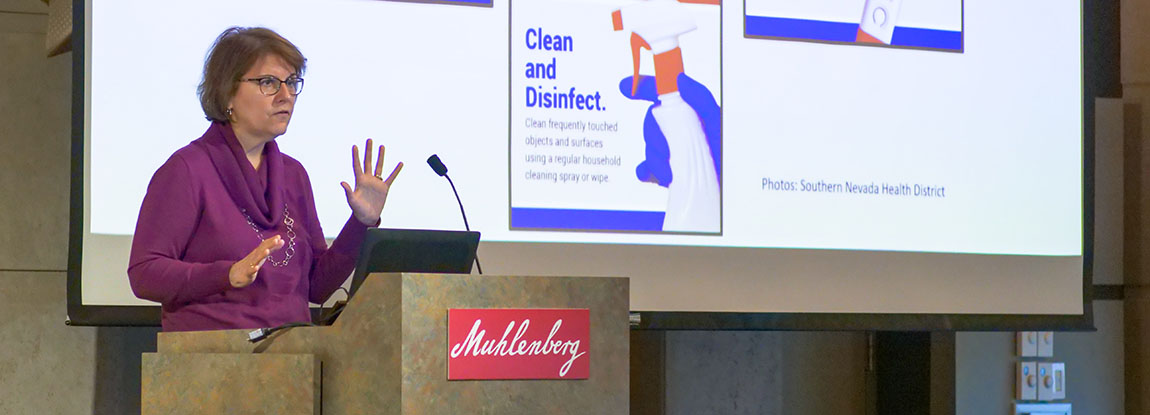How to Find Reliable Information on COVID-19
Two Muhlenberg experts share trustworthy, evidence-based sources for updates on the current pandemic.By: Meghan Kita Wednesday, March 25, 2020 08:40 AM
 Assistant Professor and Director of Public Health Chrysan Cronin presents at a College-hosted panel on COVID-19 on Tuesday, March 10.
Assistant Professor and Director of Public Health Chrysan Cronin presents at a College-hosted panel on COVID-19 on Tuesday, March 10.According to Teaching and Learning Librarian Rachel Hamelers, “When it comes to science information, a lot of people still get information from friends and family, which can be either great or problematic.” And if they’re seeking out the answer to a specific question, they might Google it—which can also be either great or problematic, depending on what rises to the top.
 Instead of turning to your social networks or a search engine, let Hamelers (pictured at right) and Assistant Professor and Director of Public Health Chrysan Cronin guide you toward reliable sources that will keep you informed as this situation develops.
Instead of turning to your social networks or a search engine, let Hamelers (pictured at right) and Assistant Professor and Director of Public Health Chrysan Cronin guide you toward reliable sources that will keep you informed as this situation develops.
First of all, what’s the difference between COVID-19 and coronavirus?
While the terms are being used somewhat interchangeably at this point, they aren’t equivalent. There are various coronaviruses, Hamelers says, and this one is just the newest. They range in severity from causing some forms of the common cold to causing something like Severe Acute Respiratory Syndrome (SARS) or Middle East Respiratory Syndrome (MERS).
COVID-19 is the name the scientific community gave the disease caused by the new coronavirus. The scientific name for the virus itself (severe acute respiratory syndrome coronavirus 2, or SARS-CoV-2) is not widely used outside the scientific community, perhaps because, per Hamelers, “that was thought to be too scary.” The World Health Organization (WHO) has more details on the terminology if you’re interested.
Where can I find reliable global, national and local information on COVID-19?
For global information, Hamelers recommends the WHO. For information about the United States, she recommends the Centers for Disease Control (CDC) or the National Institutes of Health (NIH).
Cronin agrees that all these entities are putting out reliable, factual information. However, she says the CDC and NIH are often getting their information from the Johns Hopkins Center for Health Security, which is her go-to source. It produces daily situation reports that also feed into the centralized Johns Hopkins Coronavirus Resource Center.
For local information, Hamelers recommends seeing if your city or county has a health bureau and looking to that as a resource. State-level health department pages (see Pennsylvania, New York, New Jersey, Maryland and Delaware) can also be helpful.
In terms of actual individuals she trusts, Cronin names two who have appeared with the president during COVID-19 briefings: Dr. Tony Fauci, the director of the National Institute of Allergy and Infectious Diseases, and Dr. Deborah Birx, the White House coronavirus task force coordinator. Cronin says they’re both respected, reputable scientists.
How can I tell if another source has accurate information on COVID-19?
Hamelers recommends choosing news sources that are also available in print, even if you read the stories online. If an article appears in print with a reporter’s byline attached to it, that indicates that the media organization behind it likely has a fact-checking process and that someone will be held accountable if any of the information is incorrect.
Also, because we’ve only seen this virus in humans for a few months, there’s a lot we don’t know about it. “If you’re going to a [news source] that has all the answers, that’s probably not evidence-based,” Hamelers says. “A good source will tell you, ‘We don’t know, but here’s the safest thing either way.’ I think people have to just start being comfortable with that.”
What kinds of information do I actually need to know about COVID-19?
While Hamelers and Cronin are interested in tracking the numbers on infections and deaths, that’s not critical for the average person to follow. However, says Hamelers, “It’s everyone’s civic responsibility to know what actionable items you are supposed to be taking to keep yourself and the people in your community safe.”
What that means is practicing social distancing, a term Cronin says should have been more clearly defined early on: “I do think the message should have been: Stay six feet away from people. Don’t go anywhere but to the grocery store or some kind of essential place,” meaning, to continue critical medical treatment (like chemotherapy) or to seek emergency care (like for a heart attack or a broken bone).
Even President Trump’s guidance to limit gatherings to 10 people or fewer was “kind of a bad message,” she says. “Socialize only with the people in your household” would be a better one. If one of those people is unable to practice social distancing (because they’re a medical worker, for example) or is more susceptible to serious illness, you may want to try distancing as much as possible within the home as well.
You also need to know what the COVID-19 symptoms are (fever, cough, shortness of breath) and what to do if you experience symptoms (call a health provider first—don’t just show up somewhere), Hamelers says.
On the other end of the spectrum, it’s also possible to be too informed. “We certainly are in an age of information overload. It can be unhealthy to read the news 24/7—the WHO called it an ‘infodemic.’ It’s a tidal wave of information coming at us,” Hamelers says. “If you can limit yourself to places like the CDC and the NIH and whatever major newspapers or health bureaus or things are in your town, you will not only cut out a lot of the noise, but you’ll keep yourself a little more sane.”
